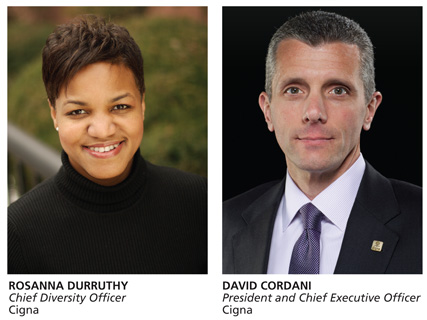 People define health and well-being in many ways, from their physical, emotional, social and financial needs. That’s why Cigna’s diversity and inclusion strategy is critical to understanding our customers’ needs and helps us to work with them to achieve healthier, more secure lives.
People define health and well-being in many ways, from their physical, emotional, social and financial needs. That’s why Cigna’s diversity and inclusion strategy is critical to understanding our customers’ needs and helps us to work with them to achieve healthier, more secure lives.
Among our stakeholders – employees, customers, partners, suppliers and communities served – there are many different cultures, beliefs and values represented. We define diversity in all of the ways we are different, from traditional definitions of race, religion, gender, age and ability to non-traditional differences such as work styles, preferred languages, veteran status or sexual orientation.
Cigna’s Leadership Team recognizes that diversity and inclusion enable the future success of the company. “Our diversity and inclusion strategy enables Cigna to deliver value in ways that recognize the unique qualities and differences of individual customers, and creates new value for them through increased productivity, better health outcomes, and reduced costs.” said David Cordani, Cigna’s President and CEO.
Rosanna Durruthy, Cigna’s Chief Diversity Officer manages our diversity strategy which focuses on customer and client needs, partner relationships – including healthcare professionals, suppliers and brokers, and community. Diversity and inclusion are essential to talent engagement, business growth, customer satisfaction and cross-cultural competence for Cigna. “Healthcare is personal and cultural in its orientation and how we relate to creating health is often rooted in our cultural beliefs and learned practices,” said Rosanna. “When we think about how we serve our customers and how we deliver value, we really think about our connection to the customer and how health and well-being is at the source of what matters most to the individual, the family, and the community. Our aim is to bring transparency and trust to the relationship, so our customers view Cigna as a valued partner.”
Additionally, Cigna’s Business Leadership Councils (BLCs) set and manage annual diversity and inclusion plans for the business. They help address gaps in diversity, inclusion, and engagement. BLCs also partner with our employee-led Colleague Resource Groups (CRGs) in areas that include recruitment, education, professional development, and volunteerism. There are nine CRGs at Cigna that meet regularly to discuss challenges to the health well-being of emerging demographics. CRGs launch initiatives that increase the understanding of particular needs within our customer segments. For example, the Hispanic CRG recently developed a white paper to help doctors and their staff better understand the cultural and health needs of our Hispanic customers. The African American CRG has worked to enhance community partnerships with organizations like the National Dental Association and the Urban League, as well as increase networking opportunities for its members and provide greater exposure and opportunities for career development education.
At the end of the day, Cigna’s promise is to understand and nurture everyone’s individual strengths to help them achieve what matters most in their life.


